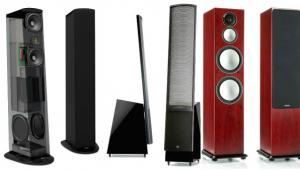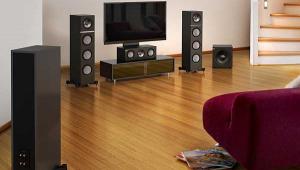HT Guide to Speakers

Despite these advances, loudspeakers remain unpopular with some people. They have practically become home theater deal breakers. Consumers who are captivated by 1080p plasmas and LCDs routinely underinvest in surround sound. Some people will only connect a pair of speakers, while others dispense with outboard audio systems altogether and rely on built-in TV speakers. Yet audio is half of home theater. Without a good speaker system and amplification, you lose much of what filmmakers intended you to hear, like surround effects and bass extension. You can pretty much kiss your relationship with music goodbye too.
Why aren't more people breaking down the doors of A/V specialty retailers? Many of them still think of speakers as bulky, décor-unfriendly, expensive objects. They may not know that the market is swarming with speaker packages that are svelte, attractive, and reasonably priced. People know that today's TVs are different. But they're not so sure about speakers.
If you'd rather watch movies on a 60-inch plasma than on a 2-inch iPod screen, you'd rather hear them in full-bodied surround than through TV speakers. You may even be a surround buff and not know it. The question is what kind of speakers you need.
Floorstanding Speakers
The largest speakers typically fit into surround systems as a vestige of the old stereo pair. Floorstanders, also called towers, may have little low-frequency extension or a lot. Some even incorporate powered subwoofers. However, it's crucial to note that you don't need floorstanders to put together a great surround sys-tem. If the primordial memory of floor-hogging speakers has put you off surround, dismiss that old stereotype from your mind. There are plenty of compact speaker systems that provide excellent performance.

Monitor Speakers
This recording studio term is, somewhat arbitrarily, our official name for stand-mount speakers. They're also known as bookshelf speakers, although a shelf is an acoustically undesirable place for any ambitious juggernaut of song.
Again, low-frequency response varies. Monitor speakers can serve in any position, including center and surround. My reference system uses five identically matched monitors with limited but significant bass response and (sometimes) a sub.

Satellite/Subwoofer Sets
Even smaller than monitors, compact satellites partly or wholly depend on their subwoofers for bass response. As more of the upper bass range is assigned to the sub, it becomes more localizable. The sub should sit as close to the center speaker as possible for good blending, while still optimizing placement for low-bass smoothness and extension. This can be challenging. Sat/sub sets range widely in price and performance. Consumers often confuse them with the low-end speakers that come with budget in-a-box systems, but the best sat/sub sets can be great performers. Whether you wall-mount them or place them on skinny stands, they are one of the best ways to add a stealthy surround system to a flat-panel HDTV.
Center Speakers
Horizontal dedicated centers are a throwback to the days when bulky TVs ruled the roost. Their persistence in the market is rooted in the popular misconception that only a horizontal speaker can serve in the center position. The people who design and market them know better. Dedicated centers usually have a left-to-right woofer-tweeter-woofer driver array that's prone to horizontal lobing. Lobing is the result of closely spaced drivers' propensity to sum and cancel each other, which causes uneven response from seat to seat around the room. Better center speakers mitigate the problem with a vertically stacked midrange and tweeter or different crossover points for the individual woofers. When a woofer-tweeter-woofer speaker operates vertically, what had been undesirable lobing can be seen as a possibly desirable limiting of vertical dispersion, which can reduce ceiling and floor reflections. The best center speakers duplicate the sonic characteristics of your front left and right speakers. An exact duplicate, placed with the same orientation, works especially well.
Dipole/Bipole Surround Speakers
Dipole/bipole surround speakers involve one or more drivers that are mounted on opposite sides of the enclosure. The speakers place the listener in a diffuse field, which prevents surround effects from calling attention to themselves. In dipole designs, front output and rear output are out of phase with each other, while they're in phase in bipole operation. Some switchable models can operate as dipole, bipole, or monopole (meaningful output from a single direction only).
Soundbar Speakers
This rapidly emerging product category provides a one-speaker stereo or surround sound solution (or two, with external sub). Well, maybe it's more of a faux-surround solution. Implementations range from low end to bleeding edge. Most include some kind of surround simulation or processing, which is typically of limited effectiveness. This might be the right surround solution for a bedroom system or summer cabin—but for your main system, you can get better performance from a well-matched speaker package and A/V receiver.

In-Wall Speakers
In-wall speakers don't need to be an acoustic compromise. Better ones include a back box or enclosure that prevents the wall cavity from turning into a resonating chamber. A few include features like flat-panel diaphragms or pivoting tweeters. Placement is crucial, so leave the installation to a professional custom installer with a thorough knowledge of acoustics.
On-Wall Speakers
Many speakers have keyhole mounts or threaded inserts, and some manufacturers design speakers expressly for on-wall use. They range in size, have shallow enclosures, and sound best when resting against the wall. Wall interaction (even when it's deliberate) is problematic. You may prefer in-wall or other speaker types over on-wall designs.

Subwoofers
The “point one” in a 5.1- or 7.1-channel array is a dedicated bass speaker. Nearly all subs come with internal amplification. You should note that amp specs given as “continuous” or RMS are less likely to be inflated than those given as “peak.” A few models have user-adjustable equalization that's designed to overcome bass bloat. For more even, powerful bass, you can use more than one sub.
- Log in or register to post comments






















































